Yingqian Zhang
Graph Reduction with Unsupervised Learning in Column Generation: A Routing Application
Apr 11, 2025Abstract:Column Generation (CG) is a popular method dedicated to enhancing computational efficiency in large scale Combinatorial Optimization (CO) problems. It reduces the number of decision variables in a problem by solving a pricing problem. For many CO problems, the pricing problem is an Elementary Shortest Path Problem with Resource Constraints (ESPPRC). Large ESPPRC instances are difficult to solve to near-optimality. Consequently, we use a Graph neural Network (GNN) to reduces the size of the ESPPRC such that it becomes computationally tractable with standard solving techniques. Our GNN is trained by Unsupervised Learning and outputs a distribution for the arcs to be retained in the reduced PP. The reduced PP is solved by a local search that finds columns with large reduced costs and speeds up convergence. We apply our method on a set of Capacitated Vehicle Routing Problems with Time Windows and show significant improvements in convergence compared to simple reduction techniques from the literature. For a fixed computational budget, we improve the objective values by over 9\% for larger instances. We also analyze the performance of our CG algorithm and test the generalization of our method to different classes of instances than the training data.
Neural Combinatorial Optimization for Stochastic Flexible Job Shop Scheduling Problems
Dec 18, 2024Abstract:Neural combinatorial optimization (NCO) has gained significant attention due to the potential of deep learning to efficiently solve combinatorial optimization problems. NCO has been widely applied to job shop scheduling problems (JSPs) with the current focus predominantly on deterministic problems. In this paper, we propose a novel attention-based scenario processing module (SPM) to extend NCO methods for solving stochastic JSPs. Our approach explicitly incorporates stochastic information by an attention mechanism that captures the embedding of sampled scenarios (i.e., an approximation of stochasticity). Fed with the embedding, the base neural network is intervened by the attended scenarios, which accordingly learns an effective policy under stochasticity. We also propose a training paradigm that works harmoniously with either the expected makespan or Value-at-Risk objective. Results demonstrate that our approach outperforms existing learning and non-learning methods for the flexible JSP problem with stochastic processing times on a variety of instances. In addition, our approach holds significant generalizability to varied numbers of scenarios and disparate distributions.
Offline Reinforcement Learning for Learning to Dispatch for Job Shop Scheduling
Sep 16, 2024



Abstract:The Job Shop Scheduling Problem (JSSP) is a complex combinatorial optimization problem. There has been growing interest in using online Reinforcement Learning (RL) for JSSP. While online RL can quickly find acceptable solutions, especially for larger problems, it produces lower-quality results than traditional methods like Constraint Programming (CP). A significant downside of online RL is that it cannot learn from existing data, such as solutions generated from CP, requiring them to train from scratch, leading to sample inefficiency and making them unable to learn from more optimal examples. We introduce Offline Reinforcement Learning for Learning to Dispatch (Offline-LD), a novel approach for JSSP that addresses these limitations. Offline-LD adapts two CQL-based Q-learning methods (mQRDQN and discrete mSAC) for maskable action spaces, introduces a new entropy bonus modification for discrete SAC, and exploits reward normalization through preprocessing. Our experiments show that Offline-LD outperforms online RL on both generated and benchmark instances. By introducing noise into the dataset, we achieve similar or better results than those obtained from the expert dataset, indicating that a more diverse training set is preferable because it contains counterfactual information.
UNCO: Towards Unifying Neural Combinatorial Optimization through Large Language Model
Aug 22, 2024



Abstract:Recently, applying neural networks to address combinatorial optimization problems (COPs) has attracted considerable research attention. The prevailing methods always train deep models independently on specific problems, lacking a unified framework for concurrently tackling various COPs. To this end, we propose a unified neural combinatorial optimization (UNCO) framework to solve different types of COPs by a single model. Specifically, we use natural language to formulate text-attributed instances for different COPs and encode them in the same embedding space by the large language model (LLM). The obtained embeddings are further advanced by an encoder-decoder model without any problem-specific modules, thereby facilitating a unified process of solution construction. We further adopt the conflict gradients erasing reinforcement learning (CGERL) algorithm to train the UNCO model, delivering better performance across different COPs than vanilla multi-objective learning. Experiments show that the UNCO model can solve multiple COPs after a single-session training, and achieves satisfactory performance that is comparable to several traditional or learning-based baselines. Instead of pursuing the best performance for each COP, we explore the synergy between tasks and few-shot generalization based on LLM to inspire future work.
Graph Neural Networks for Job Shop Scheduling Problems: A Survey
Jun 20, 2024



Abstract:Job shop scheduling problems (JSSPs) represent a critical and challenging class of combinatorial optimization problems. Recent years have witnessed a rapid increase in the application of graph neural networks (GNNs) to solve JSSPs, albeit lacking a systematic survey of the relevant literature. This paper aims to thoroughly review prevailing GNN methods for different types of JSSPs and the closely related flow-shop scheduling problems (FSPs), especially those leveraging deep reinforcement learning (DRL). We begin by presenting the graph representations of various JSSPs, followed by an introduction to the most commonly used GNN architectures. We then review current GNN-based methods for each problem type, highlighting key technical elements such as graph representations, GNN architectures, GNN tasks, and training algorithms. Finally, we summarize and analyze the advantages and limitations of GNNs in solving JSSPs and provide potential future research opportunities. We hope this survey can motivate and inspire innovative approaches for more powerful GNN-based approaches in tackling JSSPs and other scheduling problems.
Deep Multi-Objective Reinforcement Learning for Utility-Based Infrastructural Maintenance Optimization
Jun 10, 2024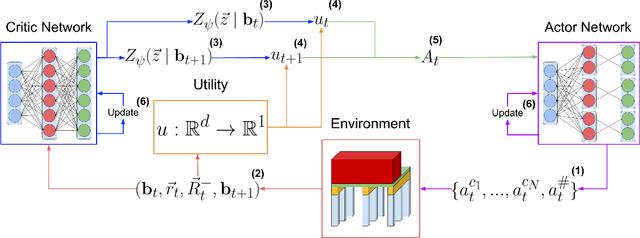
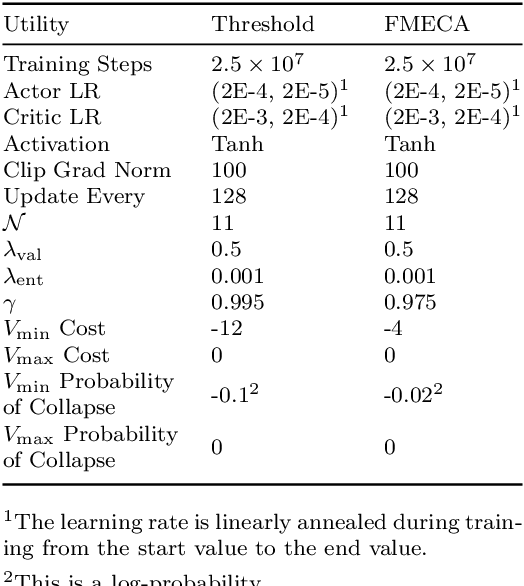
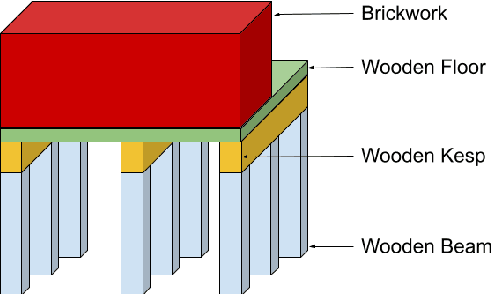

Abstract:In this paper, we introduce Multi-Objective Deep Centralized Multi-Agent Actor-Critic (MO- DCMAC), a multi-objective reinforcement learning (MORL) method for infrastructural maintenance optimization, an area traditionally dominated by single-objective reinforcement learning (RL) approaches. Previous single-objective RL methods combine multiple objectives, such as probability of collapse and cost, into a singular reward signal through reward-shaping. In contrast, MO-DCMAC can optimize a policy for multiple objectives directly, even when the utility function is non-linear. We evaluated MO-DCMAC using two utility functions, which use probability of collapse and cost as input. The first utility function is the Threshold utility, in which MO-DCMAC should minimize cost so that the probability of collapse is never above the threshold. The second is based on the Failure Mode, Effects, and Criticality Analysis (FMECA) methodology used by asset managers to asses maintenance plans. We evaluated MO-DCMAC, with both utility functions, in multiple maintenance environments, including ones based on a case study of the historical quay walls of Amsterdam. The performance of MO-DCMAC was compared against multiple rule-based policies based on heuristics currently used for constructing maintenance plans. Our results demonstrate that MO-DCMAC outperforms traditional rule-based policies across various environments and utility functions.
Cross-Problem Learning for Solving Vehicle Routing Problems
Apr 17, 2024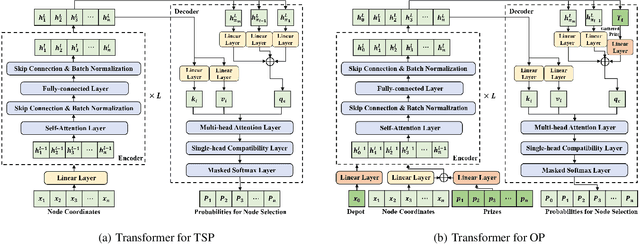

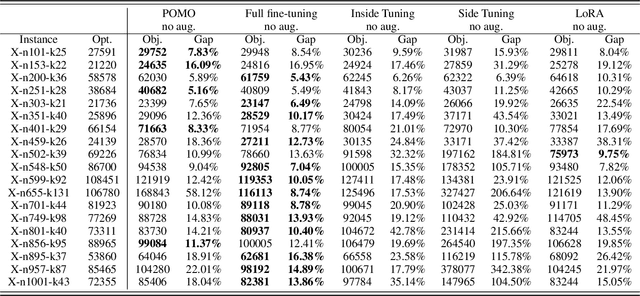

Abstract:Existing neural heuristics often train a deep architecture from scratch for each specific vehicle routing problem (VRP), ignoring the transferable knowledge across different VRP variants. This paper proposes the cross-problem learning to assist heuristics training for different downstream VRP variants. Particularly, we modularize neural architectures for complex VRPs into 1) the backbone Transformer for tackling the travelling salesman problem (TSP), and 2) the additional lightweight modules for processing problem-specific features in complex VRPs. Accordingly, we propose to pre-train the backbone Transformer for TSP, and then apply it in the process of fine-tuning the Transformer models for each target VRP variant. On the one hand, we fully fine-tune the trained backbone Transformer and problem-specific modules simultaneously. On the other hand, we only fine-tune small adapter networks along with the modules, keeping the backbone Transformer still. Extensive experiments on typical VRPs substantiate that 1) the full fine-tuning achieves significantly better performance than the one trained from scratch, and 2) the adapter-based fine-tuning also delivers comparable performance while being notably parameter-efficient. Furthermore, we empirically demonstrate the favorable effect of our method in terms of cross-distribution application and versatility.
Learning Efficient and Fair Policies for Uncertainty-Aware Collaborative Human-Robot Order Picking
Apr 09, 2024



Abstract:In collaborative human-robot order picking systems, human pickers and Autonomous Mobile Robots (AMRs) travel independently through a warehouse and meet at pick locations where pickers load items onto the AMRs. In this paper, we consider an optimization problem in such systems where we allocate pickers to AMRs in a stochastic environment. We propose a novel multi-objective Deep Reinforcement Learning (DRL) approach to learn effective allocation policies to maximize pick efficiency while also aiming to improve workload fairness amongst human pickers. In our approach, we model the warehouse states using a graph, and define a neural network architecture that captures regional information and effectively extracts representations related to efficiency and workload. We develop a discrete-event simulation model, which we use to train and evaluate the proposed DRL approach. In the experiments, we demonstrate that our approach can find non-dominated policy sets that outline good trade-offs between fairness and efficiency objectives. The trained policies outperform the benchmarks in terms of both efficiency and fairness. Moreover, they show good transferability properties when tested on scenarios with different warehouse sizes. The implementation of the simulation model, proposed approach, and experiments are published.
Parcel loss prediction in last-mile delivery: deep and non-deep approaches with insights from Explainable AI
Oct 25, 2023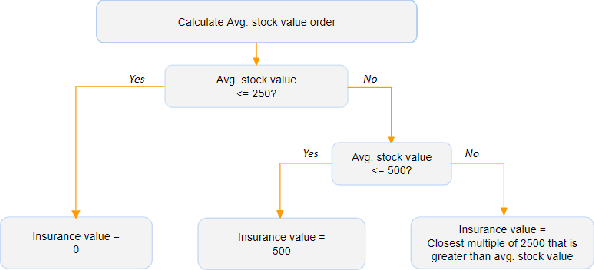



Abstract:Within the domain of e-commerce retail, an important objective is the reduction of parcel loss during the last-mile delivery phase. The ever-increasing availability of data, including product, customer, and order information, has made it possible for the application of machine learning in parcel loss prediction. However, a significant challenge arises from the inherent imbalance in the data, i.e., only a very low percentage of parcels are lost. In this paper, we propose two machine learning approaches, namely, Data Balance with Supervised Learning (DBSL) and Deep Hybrid Ensemble Learning (DHEL), to accurately predict parcel loss. The practical implication of such predictions is their value in aiding e-commerce retailers in optimizing insurance-related decision-making policies. We conduct a comprehensive evaluation of the proposed machine learning models using one year data from Belgian shipments. The findings show that the DHEL model, which combines a feed-forward autoencoder with a random forest, achieves the highest classification performance. Furthermore, we use the techniques from Explainable AI (XAI) to illustrate how prediction models can be used in enhancing business processes and augmenting the overall value proposition for e-commerce retailers in the last mile delivery.
Job Shop Scheduling Benchmark: Environments and Instances for Learning and Non-learning Methods
Aug 24, 2023
Abstract:We introduce an open-source GitHub repository containing comprehensive benchmarks for a wide range of machine scheduling problems, including Job Shop Scheduling (JSP), Flow Shop Scheduling (FSP), Flexible Job Shop Scheduling (FJSP), FJSP with Assembly constraints (FAJSP), FJSP with Sequence-Dependent Setup Times (FJSP-SDST), and the online FJSP (with online job arrivals). Our primary goal is to provide a centralized hub for researchers, practitioners, and enthusiasts interested in tackling machine scheduling challenges.
 Add to Chrome
Add to Chrome Add to Firefox
Add to Firefox Add to Edge
Add to Edge